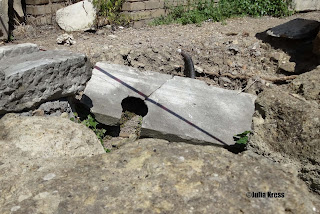 |
| the partially submerged ruins of Punta Epitaffio in the Golf of Pozzuoli |
PBS is airing Nero's Sunken City, Baiae as part of its Secrets of the Dead series, on Wednesday, March 29, 2017 at 10 pm EST. For more information go to: www.pbs.org/wnet/secrets/
Baiae (now called Baia) is a fascinating area west of Naples in Pozzuoli Bay. I have visited this region numerous times, staying in the area. However, it is an easy twenty minutes from Naples to visit Baia's Archaeological Park, the 15th century Castle of Baia and to go on a glass bottom boat or a scuba trip to see exciting underwater ruins. In addition, there are other places nearby that also offer Roman ruins and gorgeous views.
 |
| statue in the so-called Sosandra temple, first a villa then later a hotel |
Baia was where wealthy Romans went to play. It became a resort town in late Republican times with many Romans building luxurious villas on the coast seeking relaxation away from Rome. Remembered for its
decadence, the city is now halfway submerged under water due to bradyism. Bradyism is a volcanic phenomenon that has caused the water to rise submerging most of the ancient city under water.
However, the upper part of the city of Baia remains above water and can be seen by visiting the Baia Archaeological Park. This site is a wonderful place to visit because there are no tourists, a nice change from popular spots like Pompeii. It is a fairly large area located on a hillside so allow at least two hours and wear sturdy walking shoes.
 |
| the domed Roman bath, still intact |
The warm water pool was part of an extensive Roman bath complex located here. It was mistakenly thought to be a temple to Mercury. During medieval times it was called the temple of Echoes. Today it is one of the most interesting buildings to see at Baia. It still holds water today, but who knows what sea life lies beneath its murky surface.
 |
| the so-called temple to Mercury, outside view |
 |
| ancient ceiling decoration |
 |
| Roman mosaic floor |
 |
| view of Baia's Archaeological Park |
I also recommend visiting the 15th century Castle of Baia (also known as the Argonese Castle), which houses the Campi Flegrei (Burning Fields) Archaeological Museum, a collection of artifacts from Baia and the surrounding area. The Castle is allegedly the former location of a huge villa owned by Julius Caesar.
 |
| the harbor and Baia Castle |
Water surrounds this part of Italy on three sides in most places. There are mountains and sulfur pools (where Vergil's hell was located), as well as two lakes, Lake Averno and Lake Fusaro. The volcanic activity in the area is significant and includes a new mountain, the Monte Nuovo. In fact, the entire area is known as a supervolcano and consists of 24 craters located underwater.
Beyond Baia, the ruins in the area are numerous, from Cumae where the famous Sybil had her cave, to Pozzuoli with its Flavian amphitheater, to Posillipo where Vedius Pollio's villa is located, where he reputedly fed errant slaves to his eels. This intriguing area is just waiting to be explored and enjoyed!
 |
the Villa Ambulatio
|
 |
the so-called Temple to Diana - its name is based on the marble statues of deer and dogs found there
|




















